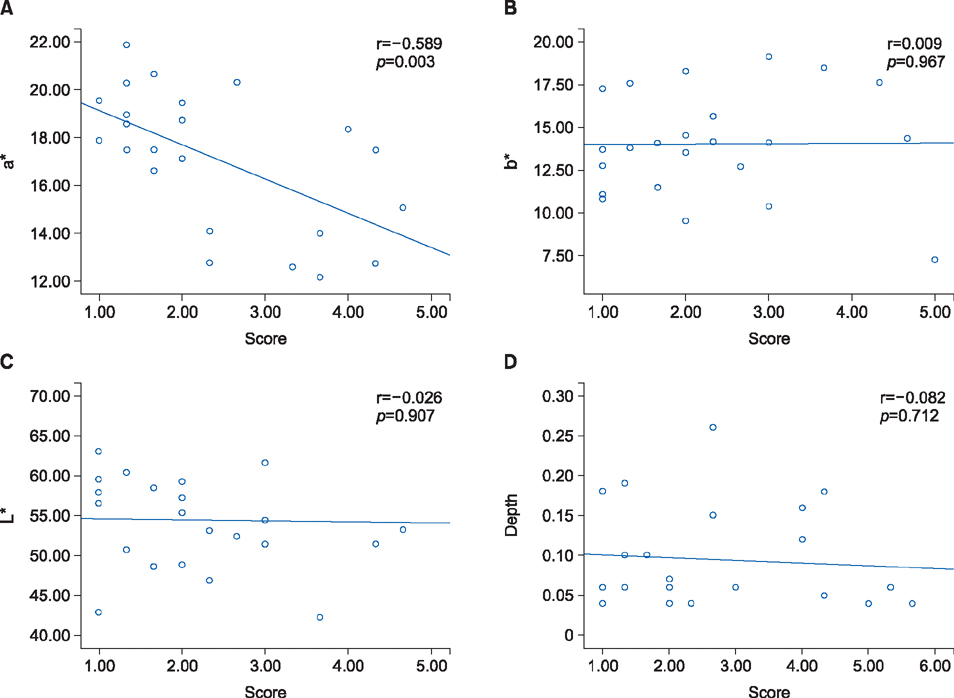Ann Dermatol.
2016 Oct;28(5):615-623. 10.5021/ad.2016.28.5.615.
Values of a Patient and Observer Scar Assessment Scale to Evaluate the Facial Skin Graft Scar
- Affiliations
-
- 1Department of Dermatology, Wonkwang University Hospital, Wonkwang University School of Medicine, Iksan, Korea.
- 2Department of Beauty Design, Wonkwang University, Iksan, Korea. jh@wku.ac.kr
- KMID: 2382887
- DOI: http://doi.org/10.5021/ad.2016.28.5.615
Abstract
- BACKGROUND
The patient and observer scar assessment scale (POSAS) recently emerged as a promising method, reflecting both observer's and patient's opinions in evaluating scar. This tool was shown to be consistent and reliable in burn scar assessment, but it has not been tested in the setting of skin graft scar in skin cancer patients.
OBJECTIVE
To evaluate facial skin graft scar applied to POSAS and to compare with objective scar assessment tools.
METHODS
Twenty three patients, who diagnosed with facial cutaneous malignancy and transplanted skin after Mohs micrographic surgery, were recruited. Observer assessment was performed by three independent rates using the observer component of the POSAS and Vancouver scar scale (VSS). Patient self-assessment was performed using the patient component of the POSAS. To quantify scar color and scar thickness more objectively, spectrophotometer and ultrasonography was applied.
RESULTS
Inter-observer reliability was substantial with both VSS and the observer component of the POSAS (average measure intraclass coefficient correlation, 0.76 and 0.80, respectively). The observer component consistently showed significant correlations with patients' ratings for the parameters of the POSAS (all p-values<0.05). The correlation between subjective assessment using POSAS and objective assessment using spectrophotometer and ultrasonography showed low relationship.
CONCLUSION
In facial skin graft scar assessment in skin cancer patients, the POSAS showed acceptable inter-observer reliability. This tool was more comprehensive and had higher correlation with patient's opinion.
MeSH Terms
Figure
Cited by 1 articles
-
Comparative Measurement of Biophysical Parameters in Consideration of Skin Graft Donor Site for Nasal Defects
Joo-Hak Kim, Chang Hwan Ahn, Sungmin Kim, Young Lee, Sang-Ha Oh
Ann Dermatol. 2019;31(1):1-5. doi: 10.5021/ad.2019.31.1.1.
Reference
-
1. Viola KV, Jhaveri MB, Soulos PR, Turner RB, Tolpinrud WL, Doshi D, et al. Mohs micrographic surgery and surgical excision for nonmelanoma skin cancer treatment in the Medicare population. Arch Dermatol. 2012; 148:473–477.
Article2. Sheehan JM, Kingsley M, Rohrer TE. Excisional surgery and repair, flaps, and graft. In : Goldsmith LA, Katz SI, Gilchrest BA, Paller AS, Leffell DJ, Wolff K, editors. Fitzpatrick's dermatology in general medicine. 8th ed. New York: McGraw-Hill;2012. p. 2944–2949.3. Idriss N, Maibach HI. Scar assessment scales: a dermatologic overview. Skin Res Technol. 2009; 15:1–5.
Article4. Draaijers LJ, Tempelman FR, Botman YA, Tuinebreijer WE, Middelkoop E, Kreis RW, et al. The patient and observer scar assessment scale: a reliable and feasible tool for scar evaluation. Plast Reconstr Surg. 2004; 113:1960–1965.
Article5. van de Kar AL, Corion LU, Smeulders MJ, Draaijers LJ, van der Horst CM, van Zuijlen PP. Reliable and feasible evaluation of linear scars by the Patient and Observer Scar Assessment Scale. Plast Reconstr Surg. 2005; 116:514–522.
Article6. Sullivan T, Smith J, Kermode J, McIver E, Courtemanche DJ. Rating the burn scar. J Burn Care Rehabil. 1990; 11:256–260.
Article7. Roques C, Teot L. A critical analysis of measurements used to assess and manage scars. Int J Low Extrem Wounds. 2007; 6:249–253.
Article8. Robinson JK, Anderson ER. Skin structure and surgical anatomy. In : Robinson JK, Hnke CW, Sengelmann RD, Siegel DM, editors. Surgery of the skin. Philadelphia: Elsevier Mosby;2005. p. 6–10.9. Draaijers LJ, Tempelman FR, Botman YA, Kreis RW, Middelkoop E, van Zuijlen PP. Colour evaluation in scars: tristimulus colorimeter, narrow-band simple reflectance meter or subjective evaluation? Burns. 2004; 30:103–107.
Article10. Takiwaki H. Measurement of skin color: practical application and theoretical considerations. J Med Invest. 1998; 44:121–126.11. Beausang E, Floyd H, Dunn KW, Orton CI, Ferguson MW. A new quantitative scale for clinical scar assessment. Plast Reconstr Surg. 1998; 102:1954–1961.
Article12. Bland JM, Altman DG. Cronbach's alpha. BMJ. 1997; 314:572.13. Landis JR, Koch GG. The measurement of observer agreement for categorical data. Biometrics. 1977; 33:159–174.
Article14. Truong PT, Lee JC, Soer B, Gaul CA, Olivotto IA. Reliability and validity testing of the Patient and Observer Scar Assessment Scale in evaluating linear scars after breast cancer surgery. Plast Reconstr Surg. 2007; 119:487–494.
Article15. Sobanko JF, Sarwer DB, Zvargulis Z, Miller CJ. Importance of physical appearance in patients with skin cancer. Dermatol Surg. 2015; 41:183–188.
Article16. Choi Y, Lee JH, Kim YH, Lee YS, Chang HS, Park CS, et al. Impact of postthyroidectomy scar on the quality of life of thyroid cancer patients. Ann Dermatol. 2014; 26:693–699.
Article17. Evans GR, Williams JZ, Ainslie NB. Cutaneous nasal malignancies: is primary reconstruction safe? Head Neck. 1997; 19:182–187.
Article18. Weathers WM, Bhadkamkar M, Wolfswinkel EM, Thornton JF. Full-thickness skin grafting in nasal reconstruction. Semin Plast Surg. 2013; 27:90–95.
Article19. Wei Y, Li-Tsang CW, Luk DC, Tan T, Zhang W, Chiu TW. A validation study of scar vascularity and pigmentation assessment using dermoscopy. Burns. 2015; 41:1717–1723.
Article20. Bray R, Forrester K, Leonard C, McArthur R, Tulip J, Lindsay R. Laser Doppler imaging of burn scars: a comparison of wavelength and scanning methods. Burns. 2003; 29:199–206.
Article21. Taylor B, McGrouther DA, Bayat A. Use of a non-contact 3D digitiser to measure the volume of keloid scars: a useful tool for scar assessment. J Plast Reconstr Aesthet Surg. 2007; 60:87–94.
Article22. Roques C, Téot L, Frasson N, Meaume S. PRIMOS: an optical system that produces three-dimensional measurements of skin surfaces. J Wound Care. 2003; 12:362–364.
Article
- Full Text Links
- Actions
-
Cited
- CITED
-
- Close
- Share
- Similar articles
-
- Analysis of Frequency of Use of Different Scar Assessment Scales Based on the Scar Condition and Treatment Method
- Efficacy of Early Application of Ablative Fractional CO2 Laser on Secondary Skin Contracture after Skin Graft
- Scar assessment after fractional CO2 laser resurfacing using a questionnaire
- Review of Scar Assessment Scales
- Simultaneous Correction of Depressed Scar Using Dermofat Graft Harvested during Scar Revision



